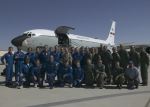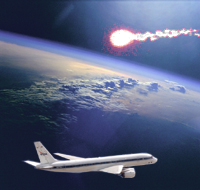|
2004 Hyperseed MAC "Genesis" campaign
First report
On September 8, 20 researchers onboard the USAF NKC-135 "FISTA" observed the Genesis SRC reentry from a location just west of the Utah Test and Training Range and at an altitude of 39,000 ft. All instruments were operational and ready for the observations. Campaign images are shown here.
 The observing campaign was only partially successful. Due to an error in calculating the position of the SRC, our narrow field-of-view spectrographs and high-speed imagers were pointed ahead of the bright SRC and did not record the reentry.
The observing campaign was only partially successful. Due to an error in calculating the position of the SRC, our narrow field-of-view spectrographs and high-speed imagers were pointed ahead of the bright SRC and did not record the reentry.
Part of the reentry track was recorded at optical (Paul Wercinski, NASA Ames), I-band near-IR (Peter Gural, SAIC; Jeremie Vaubaillon and Peter Jenniskens, SETI Institute), and mid-IR wavelengths (Eric James and Ed Schilling, NASA Ames, and George Rossano and Daryl Kiim, the Aerospace Corporation). The reentry looked like a point of light with no visible wake, a bright star falling gracefully down to Earth. The Sandia National Laboratory high-framerate photometer (Kurt Sandquist, Tim Gibson, and Dick Spalding)observed the moment of peak heating and the moment of strongest decelleration of the capsule in two narrow-band (10 nm) filters in the red and near-IR at a sampling rate of many thousands per second, detecting the spin of the capsule. This data was reduced quickly, providing a record of surface temperature and emission stability, and was used by our sponsors in the investigation of why the Genesis parachutes did not open after the fireball phase.

Compilation of still images of the Genesis SRC Entry against the background sky. Photo: Paul Wercinski / NASA Ames.
While quite bright against the deep blue sky at altitude, the SRC entry was hard to observe from the ground. Initial reports from our participating ground teams indicate that the reentry was seen visually against the bright daytime sky, albeit missed by many. It was successfully recorded with a hand-held camcorder by a team of the University of Calgary. No distinct signal was recorded at very low radio frequencies by Martin Beech and Ian Murray of the University of Regina, Canada. A sonic boom was heard at all stations and a nice infrasound record was recorded by Doug ReVelle and Roger Wiens of the Los Alamos National Laboratory's mobile 3-element infrasound array, which was set up at the Wendover, NV airport.
|









